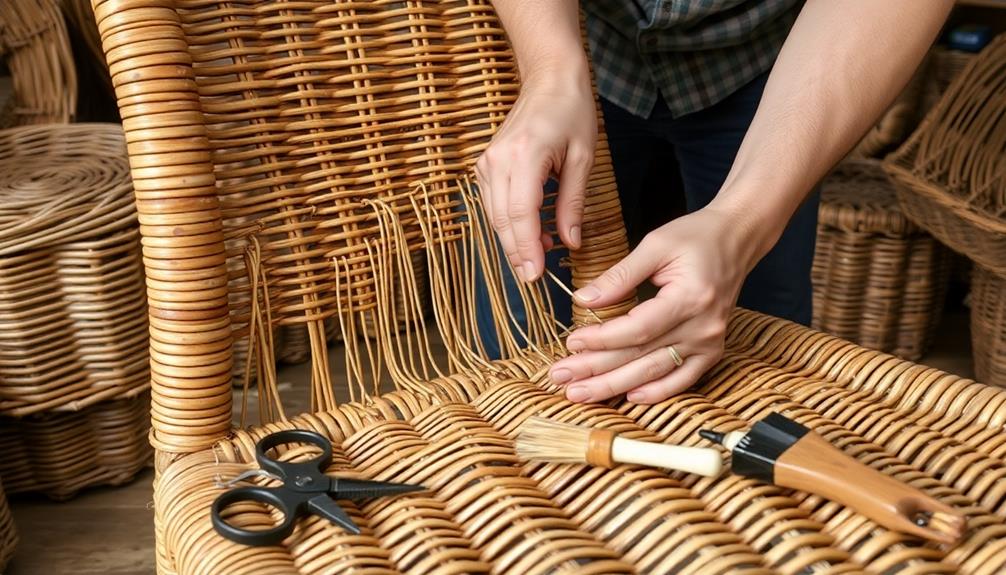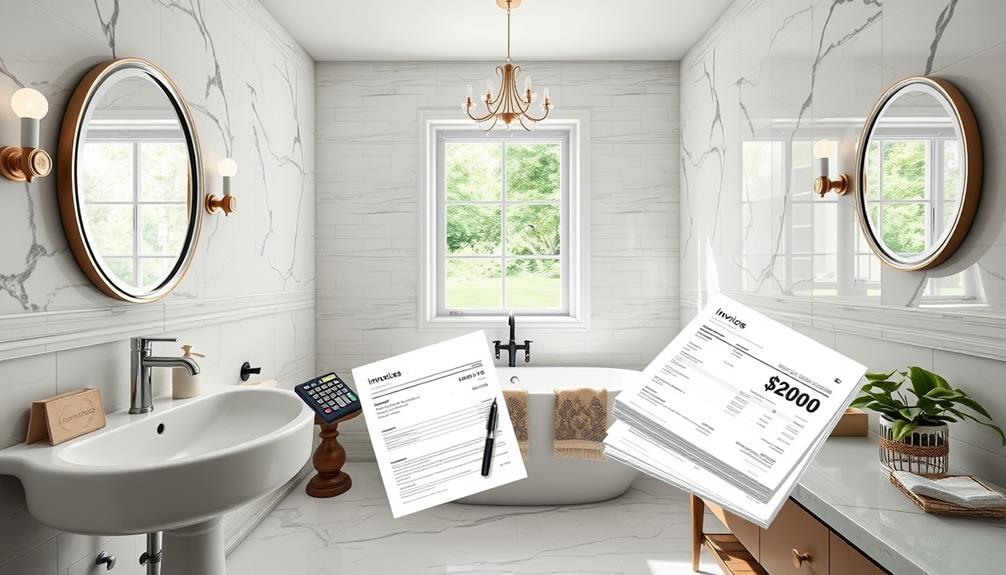For repairing your wicker furniture, begin by cleaning it with a gentle brush or a mixture of mild soap and water. Check for any broken or loose pieces and use wood glue to fix them. In case you come across damaged reeds, remove them and replace with new ones, following the original pattern closely. It is important to select replacement materials that match the diameter and color of the existing reeds. Consistent maintenance, such as preventing excessive moisture and shielding from sun exposure, will help prolong its lifespan. If you are interested in learning more tips for long-term care, there is plenty of information to delve into.
Key Takeaways
- Inspect wicker furniture regularly for broken or loose pieces and address repairs immediately to maintain structural integrity.
- Clean wicker with a mixture of mild soap and warm water, ensuring it's thoroughly dried to prevent moisture damage.
- Use wood glue for loose ends, holding them together until the glue sets for a secure bond.
- For broken reeds, cut out damaged sections and carefully weave in replacements, matching the original pattern closely.
- Consider using high-quality synthetic materials for replacements to enhance durability and weather resistance in outdoor settings.
Understanding Wicker and Rattan
Wicker furniture is often confused with rattan, but they're not the same. Wicker refers to a weaving technique used to create various types of furniture and decorative items, while rattan is a specific material derived from climbing palms, often employed in wickerwork. Rattan lacks natural water resistance, making it less suitable for outdoor use compared to synthetic wicker, which is designed to withstand the elements.
Additionally, understanding the toilet maintenance and repairs can help you appreciate the craftsmanship behind woven furniture, as both require care to maintain their functionality and aesthetic appeal.
The traditional wicker weaving technique has a rich history, dating back to ancient Egypt. It showcases the artistry and durability that woven furniture can offer.
While rattan furniture can initially handle outdoor conditions, it requires regular maintenance and protective measures to extend its lifespan. Without proper care, you might face issues like splitting or moisture damage, which can compromise the furniture's integrity.
For indoor use, rattan's flexibility is enhanced with cane, contributing to its durability. However, if you choose rattan for outdoor spaces, consider synthetic wicker instead, as it's far more resilient against weather-related wear and tear.
Understanding these differences can help you make informed choices about your furniture, ensuring it lasts for years to come.
Common Wicker Furniture Problems
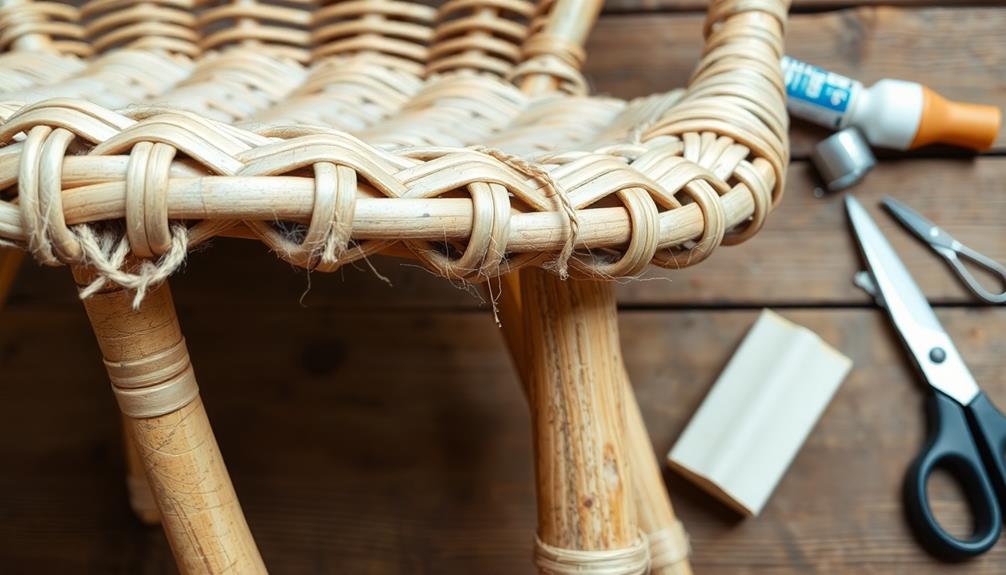
When you invest in wicker furniture, it's important to be aware of the common problems that can arise over time. These issues can greatly affect the furniture's longevity and appearance, so you need to stay vigilant.
Understanding the financial considerations for elderly care may also help you assess whether investing in durable furniture is a wise choice for your living space.
- Broken or loose pieces: These can compromise the structural integrity of your furniture, making prompt repairs essential to avoid further deterioration.
- Mildew formation: Excessive moisture can lead to mold growth, so keeping wicker furniture dry is vital. Regularly inspect for moisture build-up and use a cleaning solution to maintain its cleanliness.
- Fading and discoloration: Sunlight exposure can cause damaged wicker, but you can mitigate this with protective coatings and regular maintenance.
Additionally, cracks and splits may develop from extreme dryness or harsh elements, highlighting the need for a proper moisture balance.
During inclement weather, covering or storing your wicker furniture can help extend its lifespan. By being proactive about these common problems, you can better enjoy your wicker pieces for years to come.
Cleaning and Preparation Steps
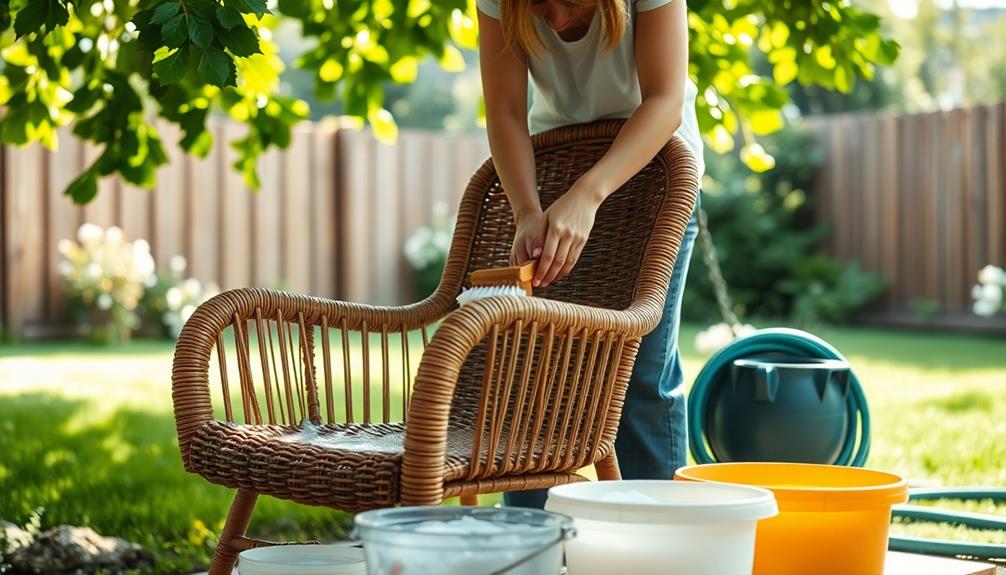
Maintaining your wicker furniture starts with proper cleaning and preparation. Begin by regularly dusting with a soft brush or vacuum to prevent dirt buildup. This simple step extends the life and appearance of your furniture.
For deep cleaning, mix mild soap with warm water. Wipe down the wicker with a damp cloth and thoroughly rinse to avoid moisture retention. Regular cleaning helps prevent damage similar to the significance of fuel injection cleaning for vehicle performance.
Before you start cleaning, make certain to remove cushions. Wash any removable covers in your washing machine and let them air dry to prevent mildew growth. Once the covers are completely dry, you can proceed to vacuum the entire sofa to remove any dust or debris. For a more thorough clean, use a fabric-safe cleaner and a soft cloth to gently wipe down the surfaces. If you’re unsure about how to put sofa cover back on properly, refer to the manufacturer’s instructions to ensure a snug and secure fit. After wiping down the surfaces, allow the sofa to air out before reassembling the cushions. For tips on how to cover a 3seater properly, be sure to smooth out any wrinkles to maintain the sofa’s appearance. A well-fitted cover will not only enhance the look but also protect your furniture from wear and tear.
For disinfecting, prepare a solution of 1L water mixed with 250ml bleach. Wipe down the wicker with this solution to combat mold, then allow it to air dry for about 2-3 hours.
It's essential to guarantee the wicker is completely dry before proceeding with repairs. Trapping moisture can lead to damaged reeds and further issues down the line.
Repair Techniques for Wicker
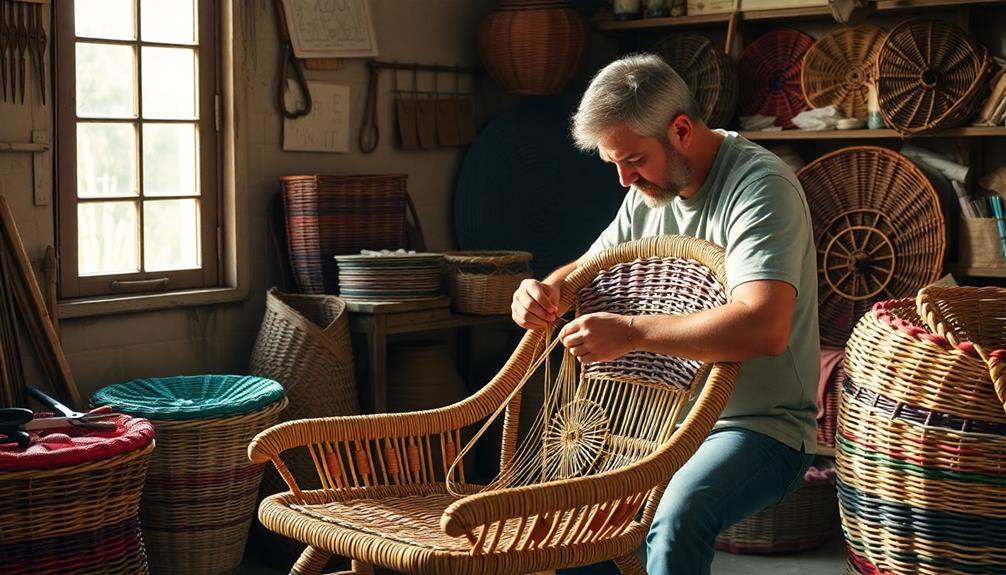
Before diving into repairs, it's crucial to assess the damage to your wicker furniture carefully. Look for frayed, broken, or missing reeds and evaluate the structural integrity. This initial inspection will guide your wicker furniture repair efforts.
Here are some key repair techniques to take into account:
- Use wood glue for loose ends: Apply a small amount at the base of the loose reed, tuck it back into the wicker pattern, and hold it for about 30 seconds to bond effectively.
- Handle broken reeds: Cut out the damaged sections from the underside. Soak your replacement reed in warm water for flexibility, then weave it into the existing pattern. Secure the ends with glue.
- Focus on reweaving: Start from a less visible area to maintain aesthetics. Follow the original wicker pattern closely for seamless integration, and use pliers for tight spots.
Regular inspection and cleaning of your wicker furniture help prevent further damage. By addressing repairs promptly, you'll maintain the structural integrity and appearance of your beloved pieces.
Choosing Replacement Materials

Selecting the right replacement materials for your wicker furniture is vital for achieving a seamless repair. Start by determining whether you'll use natural rattan, synthetic resin, or vinyl as your replacement materials. Each type has its own benefits and compatibility with your existing furniture.
Before purchasing, measure the diameter and color of the existing reeds to guarantee a close match. Opt for high-quality replacement reeds that are flexible and durable. To enhance their pliability, soak them in warm water before weaving.
When it's time to replace the reeds, pay close attention to the original weave pattern. Accurately replicating this pattern is essential for maintaining both structural integrity and aesthetic consistency.
Here's a quick reference table to guide your selection:
| Material Type | Key Considerations |
|---|---|
| Natural Rattan | Eco-friendly, traditional appearance |
| Synthetic Resin | Durable, weather-resistant |
| Vinyl | Versatile, easy to maintain |
| High-Quality Reeds | Flexible, strong, soak for pliability |
Lastly, always purchase extra materials. Wicker furniture can wear over time, and having supplies on hand will make future repairs easier.
Frequently Asked Questions
Is It Worth It to Repair Wicker Furniture?
Yes, it's worth it to repair wicker furniture. You can save money, restore sentimental pieces, and enjoy the satisfaction of DIY projects. Plus, with proper care, your wicker can last for many more years.
Is There a Way to Repair Wicker?
Imagine your beloved wicker chair, its once-sturdy frame now fraying. You can repair it! By identifying damaged areas, weaving in new reeds, and securing them, you'll breathe new life into that cherished piece.
How to Update Wicker Furniture?
To update your wicker furniture, clean it thoroughly, repaint with quality outdoor paint, and replace old cushions with vibrant outdoor fabrics. Add decorative pillows and regularly apply a protective sealant for lasting beauty and durability.
How to Fix Broken Rattan Furniture?
Did you know that about 60% of furniture damage happens during moving? To fix broken rattan furniture, assess the damage, cut out broken strands, soak replacements, weave them in, and secure with glue for stability.
Conclusion
In the world of furniture repair, "a stitch in time saves nine." By understanding the nature of wicker and addressing common issues promptly, you can extend the life of your beloved pieces. With the right cleaning, preparation, and repair techniques, you'll have your wicker furniture looking as good as new. Don't wait until it's too late—take action now to preserve your investment and enjoy your stylish, comfortable seating for years to come!
